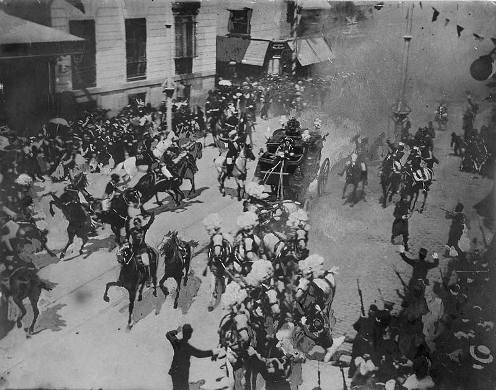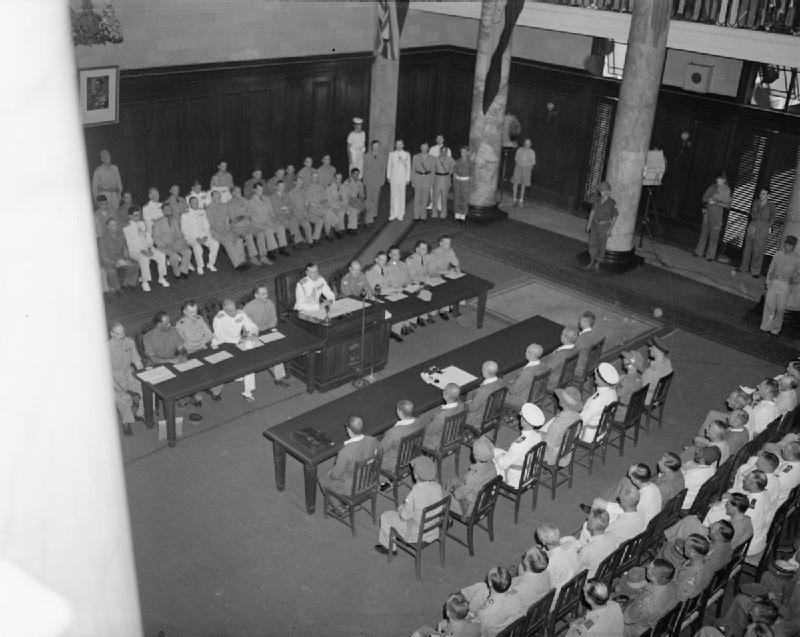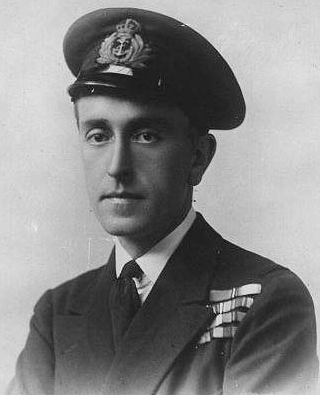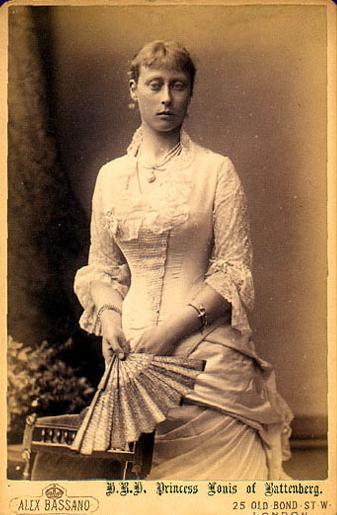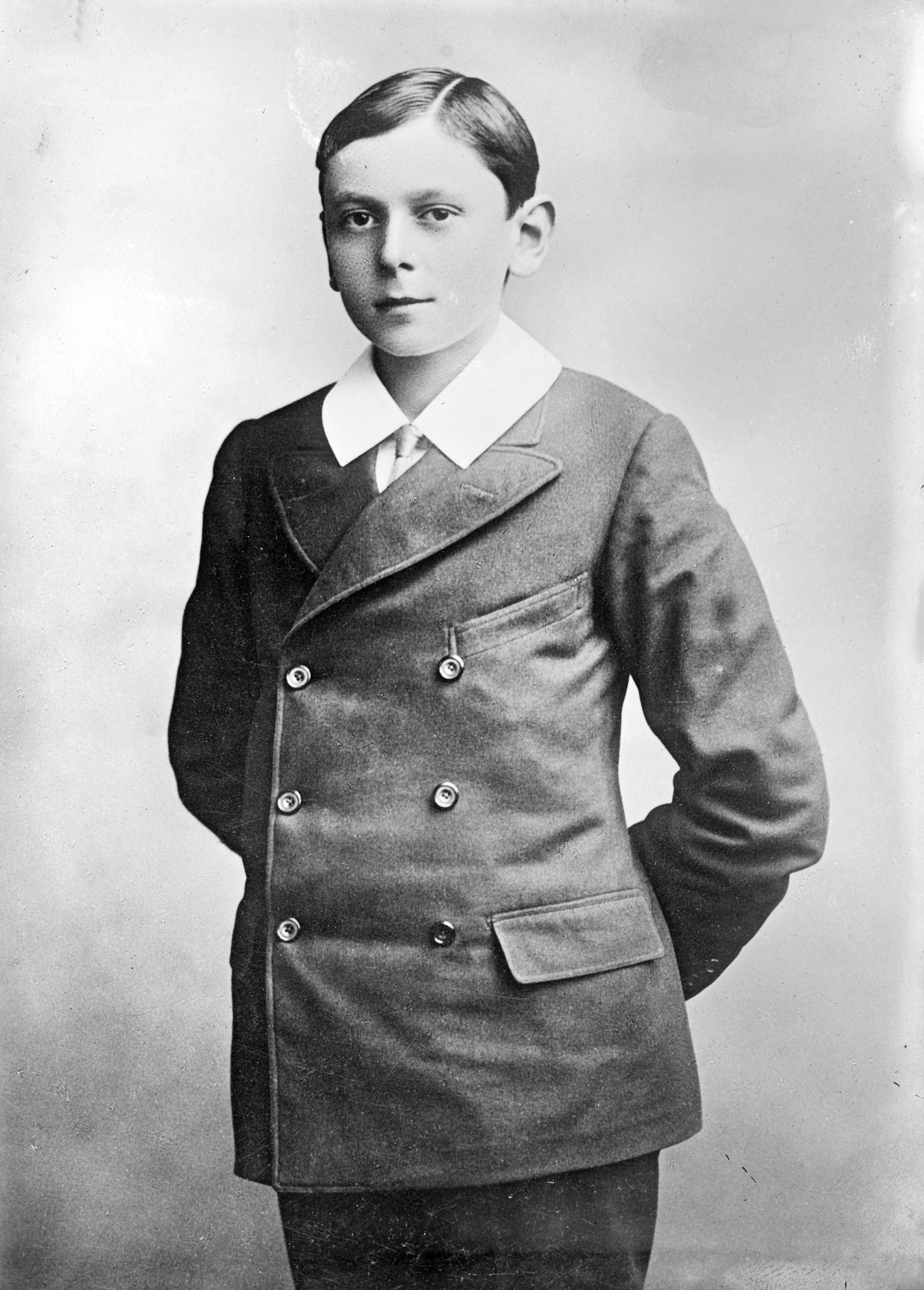by Susan Flantzer © Unofficial Royalty 2019

The Marriage of Princess Beatrice by Richard Caton Woodville painted for Queen Victoria. Princess Beatrice is accompanied to the altar by her brother, the Prince of Wales, and Queen Victoria. Her nieces were bridesmaids, but only eight out of the total of ten are shown in the painting; Credit – Royal Collection Trust
Princess Beatrice of the United Kingdom and Prince Henry of Battenberg were married on July 23, 1885, at Saint Mildred’s Church in Whippingham, Isle of Wight, England.
Beatrice’s Early Life
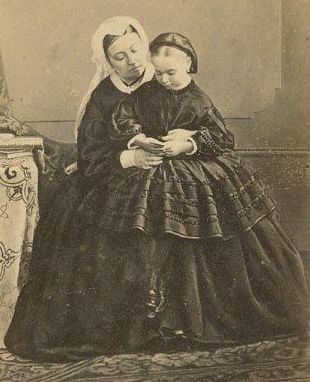
Princess Beatrice with her mother Queen Victoria; Credit – Wikipedia
Princess Beatrice was born on April 14, 1857, at Buckingham Palace in London, England. She was the youngest of the nine children of Queen Victoria of the United Kingdom and Prince Albert of Saxe-Coburg and Gotha. On December 14, 1861, Prince Albert died at the age of 42. Beatrice was only four and a half and had lost one of her principal role models. Queen Victoria was grief-stricken. The night Prince Albert died, Queen Victoria went into the nursery and carried the sleeping Beatrice to her own bed, where she lay unable to sleep, hugging Beatrice while wrapped in the bedclothes of her deceased husband. Because of her mother’s prolonged grief and mourning, Beatrice’s life would forever be shaped by her father’s death. She became a great solace to her mother, and as the years progressed Queen Victoria hoped that Beatrice would always be her constant companion.
Despite her father’s death, Beatrice’s education proceeded according to the plan Prince Albert had devised for all his children. She received lessons in French and German and received a hands-on history education by visiting historical sites. Unlike her mother, Beatrice eventually had clear and legible handwriting and was an accurate speller. By the age of fifteen, Beatrice was writing letters on behalf of Queen Victoria and she was developing into the quiet, attentive, and devoted helper the Queen wanted. When the last of her sisters married and left home, Beatrice took on the job of being her mother’s full-time personal assistant.
To learn more about Beatrice, see Unofficial Royalty: Princess Beatrice of the United Kingdom, Princess Henry of Battenberg
Henry’s Early Life

Prince Henry of Battenberg; Credit – Wikipedia
Prince Henry (Heinrich) of Battenberg was born on October 5, 1858 in Milan, Kingdom of Lombardy-Venetia, now in Italy. Henry (nicknamed Liko) was the fourth of the five children and the third of the four sons of Prince Alexander of Hesse and by Rhine and Countess Julia Hauke. As his parents’ marriage was morganatic, Henry and his siblings took their titles from their mother, who had been created Countess of Battenberg and was later elevated to Princess of Battenberg in 1858.
Henry received a military education and was commissioned a lieutenant in the 1st Regiment of the Rhenish Hussars of the Prussian Army. He also served in the Gardes du Corps, the personal bodyguard of the King of Prussia and, after 1871, of the German Emperor.
To learn more about Henry, see Unofficial Royalty: Prince Henry of Battenberg
The Engagement

Prince Henry giving an engagement ring to Princess Beatrice, illustration from “The Penny Illustrated Paper” (Jan 24 1885); Credit – The British Museum
In 1884, Henry’s brother Prince Louis of Battenberg married Princess Victoria of Hesse and by Rhine, the eldest child of Queen Victoria’s third child Alice, Grand Duchess of Hesse and by Rhine. Of course, Henry attended the wedding in Darmstadt and so did the bride’s aunt, Princess Beatrice. Queen Victoria had expectations that Beatrice would never marry and would remain her personal assistant and secretary. However, during the wedding celebrations, Henry and Beatrice fell in love. When Beatrice told her mother of her desire to marry Henry, Queen Victoria did not speak to Beatrice for seven months. Eventually, the Queen realized that Beatrice would not back down and with some persuasion from the Prince of Wales, Alice’s widower Ludwig IV, Grand Duke of Hesse and by Rhine, and Henry’s brother Prince Louis of Battenberg, Queen Victoria decided to allow the marriage with several conditions: Henry must renounce his military career, his nationality, and his home and agree to live with Beatrice and the Queen.
Wedding Site

St. Mildred’s Church, Whippingham; Credit – By Mypix at English Wikipedia, CC BY-SA 4.0, https://commons.wikimedia.org/w/index.php?curid=57460350
Saint Mildred’s Church in Whippingham, Isle of Wight, England was where Queen Victoria and her family worshipped when in residence at Osborne House, the beloved home Queen Victoria and Prince Albert built on the Isle of Wight. The original church was redesigned by architect Albert Jenkins Humbert with the input of Prince Albert. The chancel of the church was built in 1854 – 1855 and the remainder of the church was constructed in 1861 – 1862. A side chapel, originally used by members of the household at Osborne House when worshipping at Whippingham, was later made into a shrine, the Battenberg Chapel, upon the early death of Prince Henry of Battenberg. Several family members are buried there including Prince Henry and his wife Princess Beatrice.
Wedding Guests
Since Saint Mildred’s Church was a small, parish church, the guest list had to be limited. Also, because there were limited places for royal relations and guests from abroad to stay on the Isle of Wight, the royal yachts served as floating hotels.
Royal Guests
- Queen Victoria, mother of the bride
- The Prince of Wales, later King Edward VII, brother of the bride
- The Princess of Wales, later Queen Alexandra, sister-in-law of the bride
- Prince Albert Victor of Wales, nephew of the bride
- Prince George of Wales, later King George V, nephew of the bride
- Princess Louise of Wales, niece of the bride
- Princess Victoria of Wales, niece of the bride
- Princess Maud of Wales, niece of the bride
- Prince Alfred, Duke of Edinburgh, brother of the bride
- The Duchess of Edinburgh, born Grand Duchess Maria Alexandrovna of Russia, sister-in-law of the bride
- Prince Alfred of Edinburgh, nephew of the bride
- Princess Marie of Edinburgh, niece of the bride
- Princess Victoria Melita of Edinburgh, niece of the bride
- Princess Alexandra of Edinburgh, niece of the bride
- Prince Arthur, Duke of Connaught, brother of the bride
- The Duchess of Connaught, born Princess Louise Margaret of Prussia, sister-in-law of the bride
- Princess Margaret of Connaught, niece of the bride
- Princess Christian of Schleswig-Holstein, Princess Helena, sister of the bride
- Prince Christian of Schleswig-Holstein, brother-in-law of the bride
- Princess Helena Victoria of Schleswig-Holstein, niece of the bride
- Princess Marie Louise of Schleswig-Holstein, niece of the bride
- Princess Louise, Marchioness of Lome, sister of the bride
- John Campbell, Marquis of Lome, brother-in-law of the bride
- Prince George, 2nd Duke of Cambridge, first cousin once removed of the bride
- Prince Edward of Saxe-Weimar
- Ernst, 4th Prince of Leiningen, first cousin of the bride
- Princess of Leiningen wife of Ernst, born Princess Marie of Baden
- Prince Alexander of Hesse and by Rhine, father of the groom
- Princess of Battenberg, born Countess Julie Hauke, mother of the groom
- Prince Louis of Battenberg, brother of the groom
- Princess Louis of Battenberg, born Princess Victoria of Hesse and by Rhine, niece of the bride and first cousin once removed of the groom
- Alexander (of Battenberg), Prince of Bulgaria, brother of the groom
- Prince Franz Joseph of Battenberg, brother of the groom
- Count Gustav Ernst of Erbach-Schoenberg, brother-in-law of the groom
- Countess of Erbach-Schoenberg, born Princess Marie of Battenberg, sister of the groom
- Ludwig IV, Grand Duke of Hesse and by Rhine, brother-in-law of the bride and first cousin of the groom
- Ernst Ludwig, Hereditary Grand Duke of Hesse of Hesse and by Rhine, nephew of the bride and first cousin once removed of the groom
- Princess Irene of Hesse of Hesse and by Rhine, niece of the bride and first cousin once removed of the groom
- Princess Alix of Hesse of Hesse and by Rhine, niece of the bride and first cousin once removed of the groom
- Prince Philip of Saxe-Coburg and Gotha, second cousin of the bride
Invited Guests
- William FitzRoy, 6th Duke of Grafton
- Francis Russell, 9th Duke of Bedford and Elizabeth Russell, Duchess of Bedford
- Susanna Innes-Kerr, Dowager Duchess of Roxburghe
- James Butler, 3rd Marquess of Ormonde and Elizabeth Butler, Marchioness of Ormonde
- Spencer Cavendish, Marquis of Hartington
- John Poyntz Spencer, 5th Earl Spencer
- Louisa McDonnell, Countess of Antrim
- Valentine Browne, 4th Earl of Kenmare
- Granville Leveson-Gower, 2nd Earl Granville
- John Townshend, 1st Earl Sydney
- Standish Vereker, 4th Viscount Gort, Caroline Vereker, Viscountess Gort and The Honorable Miss Vereker
- Admiral Lord Frederick Kerr
- General Lord Alfred Paget and The Honorable Evelyn Paget
- Lieutenant-General Dudley FitzGerald-de Ros, 23rd Baron de Ros
- Ismania FitzRoy, Baroness Southampton and The Honorable Frederica Fitzroy
- Thomas Hovell-Thurlow-Cumming-Bruce, 5th Baron Thurlow
- Emily Cavendish, Lady Waterpark
- Frederick Methuen, 2nd Baron Methuen
- General Lord Wolseley
- Prince Lichnowsky
- Count Alexander Münster
- Count Vitzthum
- Colonel The Honorable C. H. Lindsay
- Sir Edward Malet and Lady Ermyntrude Malet
- Captain The Honorable A. Denison
- The Honorable Flora Macdonald
- General Sir Francis Seymour, 1st Baronet
- Lady Cowell
- Sir Robert Collins
- Sir William Carter Hoffmeister, Surgeon to Queen Victoria
- Captain Sir Alfred Balliston
- Fraulein Bassing
- Miss Bauer, Beatrice’s former German tutor, now one of Queen Victoria’s readers
- Mr. Doyne C. Bell
- Miss Biddulph
- Mr. W. Campbell of Blythswood
- Reverend A. Campbell, Vicar of Crathie Church near Balmoral in Scotland
- Madame de Arcos
- Reverend Canon Robinson Duckworth, former tutor to Prince Leopold
- Mrs. F. I. Edwards
- Miss Jessie Ferrari, singer and music teacher
- Captain Fisher
- Mr. Frederick Gibbs, former tutor to The Prince of Wales and Prince Alfred
- Mr. Charles Hallé, pianist and conductor
- Rear-Admiral F. A. Herbert
- Dr. John Hoffmeister
- Mr. R. R. Holmes, Librarian of Windsor Castle
- Lieutenant-Colonel George Ashley Maude, Crown Equerry of the Royal Mews
- Mademoiselle Norelle, former French tutor to Queen Victoria’s children
- Miss Alberta Ponsonby and Miss Magdalen Ponsonby, daughters of Sir Henry Frederick Ponsonby, Queen Victoria’s Private Secretary
- Dr. Alexander Profeit, Commissioner of Works at Balmoral Castle
- Mrs. and Miss Prothero, wife and daughter of Reverend Canon George Prothero, Rector of Whippingham and Chaplain in Ordinary to Her Majesty
- Mr. Hermann Sahl, Librarian and German Secretary to Queen Victoria
- Colonel Stockwell
- Reverend Canon C. F. Tarver, former tutor to The Prince of Wales
- Signer Tosti, composer of romantic and drawing-room songs
- Captain Webbe and Lady Cecilia Webbe
- Captain Welch
- Miss Van de Weyer
- Mr. Arnold White
- The Mayor of Newport, Isle of Wight, England
The Queen’s Household
- Louisa Montagu Douglas Scott, Duchess of Buccleuch, Mistress of the Robes
- Jane Loftus, Dowager Marchioness of Ely, Lady of the Bedchamber in Waiting
- The Honourable Harriet Phipps, Maid of Honor in Waiting
- The Honorable Maude Okeover, Maid of Honor in Waiting
- William Edgcumbe, 4th Earl of Mount Edgcumbe, Lord Steward
- Edward Bootle-Wilbraham, 1st Earl of Lathom, Lord Chamberlain
- Orlando Bridgeman, 3rd Earl of Bradford, Master of the Horse
- William Heneage, Viscount Lewisham, Vice-Chamberlain
- Major-General Sir J. C. McNeill, Equerry-in-Waiting
- Colonel H. P. Ewart, Equerry-in-Waiting
- General Sir Henry Ponsonby, Private Secretary and Keeper of the Privy Purse
- Major-General Sir John Cowell, Master of the Household
- The Honourable Sir S. Ponsonby-Fane, Comptroller in The Lord Chamberlain’s Department
- Mr. Conway Seymour, Gentleman Usher
- Mr. Arnold Royle, Gentleman Usher
- Sir William Jenner, 1st Baronet, Physician in Ordinary to Her Majesty
- Dr. James Reid, Resident Physician to Her Majesty
Attendant on the Bridegroom
- Major F. I. Edwards, Groom in Waiting to the Queen, in attendance on Prince Henry of Battenberg
Attendants on the Bride
- Miss M. Cochrane, Lady in Waiting on Princess Beatrice
- The Honourable Lady Biddulph, Lady in Waiting on Princess Beatrice
- Jane Spencer, Baroness Churchill, Acting Lady in Waiting on Princess Beatrice
Attendants on Other Royalty
- Major-General Bateson, Equerry in Waiting on The Duke of Cambridge.
- The Honorable Lady Ponsonby, Acting Lady in Waiting on Princess Louise, Marchioness of Lorne
- Baron d’Ablaing de Giessenbuvg, Gentleman in Waiting on Prince Philip of Saxe-Coburg and Gotha.
- Colonel Baron Rotsmann, Equerry in Waiting on Prince Alexander of Hesse and by Rhine
- Lieutenant-Colonel Honorable W. Carington, Equerry in Waiting on The Queen, in attendance on Prince Alexander of Hesse and by Rhine
- Hoffrath Munther, Gentleman in Waitng on Ernst Ludwig, Hereditary Grand Duke of Hesse and by Rhine
- Lieutenant-Colonel Wernher, Equerry in Waiting on Ludwig IV, Grand Duke of Hesse and by Rhine
- Captain Arthur J. Bigge, Equerry in Waiting to The Queen, in attendance Ludwig IV, Grand Duke of Hesse and by Rhine
- The Honorable A. Yorke, Acting Equerry in Waiting on Prince Christian of Schleswig-Holstein
- Miss Loch, Lady in Waiting on Princess Christian of Schleswig-Holstein
- Colonel Sir Howard Elphinstone, Comptroller to The Duke of Connaught
- Major Francis H. Poors, Equerry in Waiting on The Duke of Connaught
- The Honorable Ethel Cadogan, Acting Lady in Waiting on The Duchess of Connaught
- Lady Harriot Poore, Lady in Waiting on The Duchess of Edinburgh
- Lord Colville of Culross, Chamberlain to The Prince of Wales
- The Honorable H. Tyrwhitt Wilson, Equerry in Waiting to The Prince of Wales
- Lieutenant-General Sir Dighton M. Probyn, Comptroller and Treasurer to The Prince of Wales
- The Honorable Mrs. Coke, Lady of the Bedchamber to Her Royal Highness to The Princess of Wales
- Baron Riedesel, Marshal of the Court to The Prince of Bulgaria
- Mr. Topchileschtoff, Secretary to The Prince of Bulgaria
- Colonel Lord E. Pelham Clinton, Groom in Waiting to The Queen, in attendance on The Prince of Bulgaria
Bridesmaids and Supporters

Wedding of Princess Beatrice of the United Kingdom and Prince Henry of Battenberg (see below for who’s who in the photo); Photo Credit – www.victorian-gothic.co.uk
THE BACK: (L-R): Prince Alexander of Bulgaria, Princess Louise of Wales, Princess Irene of Hesse and by Rhine, Princess Victoria of Wales, Prince Franz Joseph of Battenberg * THE MIDDLE: (L-R): Princess Maud of Wales, Princess Alix of Hesse and by Rhine, Princesses Marie Louise and Helena Victoria of Schleswig-Holstein * THE FRONT: (L-R): Princesses Victoria Melita, Marie, and Alexandra of Edinburgh and the bridal couple.
The supporters of Prince Henry of Battenberg were his brothers Alexander (of Battenberg), Prince of Bulgaria and Prince Franz Joseph of Battenberg. Princess Beatrice’s supporters were her mother Queen Victoria and her eldest brother The Prince of Wales.
The ten royal bridesmaids were granddaughters of Queen Victoria and nieces of Princess Beatrice, ranging in age from seven-years-old to nineteen-years-old:
- Princess Louise of Wales, daughter of The Prince of Wales, the future King Edward VII, married Alexander Duff, 1st Duke of Fife
- Princess Victoria of Wales, daughter of The Prince of Wales, the future King Edward VII, unmarried
- Princess Maud of Wales, daughter of The Prince of Wales, the future King Edward VII, married King Haakon VII of Norway
- Princess Marie of Edinburgh, daughter of Prince Alfred, Duke of Edinburgh, the future Duke of Saxe-Coburg and Gotha, married King Ferdinand I of Romania
- Princess Victoria Melita of Edinburgh, daughter of Prince Alfred, Duke of Edinburgh, the future Duke of Saxe-Coburg and Gotha, married (1) Ernst Ludwig, Grand Duke of Hesse and by Rhine, divorced (2) Grand Duke Kirill Vladimirovich of Russia
- Princess Alexandra of Edinburgh, daughter of Prince Alfred, Duke of Edinburgh, the future Duke of Saxe-Coburg and Gotha, married Prince Ernst II of Hohenlohe-Langenburg
- Princess Irene of Hesse and by Rhine, daughter of the late Princess Alice, Grand Duchess of Hesse and by Rhine, married Prince Heinrich of Prussia
- Princess Alix of Hesse and by Rhine, daughter of the late Princess Alice, Grand Duchess of Hesse and by Rhine, married Nicholas II, Emperor of All Russia
- Princess Helena Victoria of Schleswig-Holstein, daughter of Princess Helena, Princess Christian of Schleswig-Holstein, unmarried
- Princess Marie Louise of Schleswig-Holstein, daughter of Princess Helena, Princess Christian of Schleswig-Holstein, married Prince Aribert of Anhalt, marriage dissolved
Wedding Attire

Prince Henry and Princess Beatrice on their wedding day; Credit – Wikipedia
Upon Queen Victoria’s insistence, Prince Henry of Battenberg wore the rather dashing white cuirassier uniform of Prussian Garde Du Corps, the personal bodyguard of the King of Prussia and, after 1871, of the German Emperor.
The ten royal bridesmaids were dressed in high-necked white dresses with flounced skirts and carried bouquets of stephanotis.

Credit – Royal Collection Trust
Princess Beatrice’s wedding dress was made of white satin, trimmed with orange blossoms, white heather, myrtle, and lace. There was lace on the pointed neckline, and on the sleeves. Princess Beatrice loved lace and became an expert on lace. Knowing this, Queen Victoria allowed Princess Beatrice to wear the precious Honiton lace veil that she had worn on her wedding day. Beatrice was the only one of her daughters to be given the opportunity to wear it. Atop her head, Beatrice wore an orange blossom wreath and a diamond circlet with diamond stars, a wedding gift from her mother.
Beatrice wore diamond collet drop earrings, a diamond collet necklace with a diamond cross suspended from it, a diamond bee brooch, a diamond rose brooch, and a large diamond butterfly brooch. On her right wrist, she wore a wide diamond and sapphire bracelet, gift of the groom, and on her left wrist, she wore five bangle bracelets, some with diamonds and others plain gold. Beatrice wore the Order of Victoria and Albert, the Crown of India, the Gold Lion of Hesse, the Royal Red Cross, and the Saxe-Coburg and Gotha family order.
The Wedding
Clergy Officiating
- Edward White Benson, Archbishop of Canterbury
- Harold Browne, Bishop of Winchester
- The Very Reverend Randall T. Davidson, Dean of Windsor, Domestic Chaplain to Her Majesty
- Reverend Canon George Prothero, Rector of St. Mildred’s Church, Whippingham and Chaplain in Ordinary to Her Majesty
Music provided by:
- Walter Parratt, Organist of St. George’s Chapel, Windsor
- Choir of St. George’s Chapel, Windsor
A special train carrying the wedding guests, along with the members of The Queen’s Household and those in attendance on the royalty who were not already at Osborne House, left Victoria Station in London at 9 AM on the day of the wedding. The train arrived at Portsmouth, England where the royal yacht Alberta was waiting to take them across The Solent to the Isle of Wight. Carriages were provided for the trip to St. Mildred’s Church, Whippingham. Upon arrival at the church, the guests were shown to their seats by Her Majesty’s Gentlemen Ushers.
At 12:40 PM, the Archbishop of Canterbury, the Bishop of Winchester, the Dean of Windsor, and the Rector of St. Mildred’s Church, Whippingham arrived from the church rectory with the choir and took their places at the altar while a voluntary was played on the organ.
At 12:30, the royal family and other royalty left Osborne House with their attendants in a carriage procession. They were received at the church gate by the Lord Chamberlain and the Lord Steward, who, with the Vice-Chamberlain, conducted them to the seats in the royal pews. The Princess of Wales, Ludwig IV, Grand Duke of Hesse and by Rhine, and the groom’s parents, Prince Alexander of Hesse and by Rhine and the Princess of Battenberg, were seated in front of the altar. Georg Friedrich Handel’s March from The Occasional Overture was played as the royal procession moved down the aisle. The royal attendants were shown to seats at the back of the royal and household pews. Meanwhile, the Prince of Wales waited for the arrival of the bride at the church gate.
The ten royal bridesmaids, all nieces of the bride, arrived at 12:45 PM and waited for the arrival of the bride in the church vestry. Ten minutes later, the groom arrived with his supporters, his brothers Alexander (of Battenberg), Prince of Bulgaria and Prince Franz Joseph of Battenberg. As a march by Walter Parratt, the organist of St. George’s Chapel, Windsor Castle, was played, they were conducted to their places on the right of the altar.
As the bride’s carriage procession approached the church, the bridesmaids were escorted to the church gate. Princess Beatrice with Queen Victoria and The Prince of Wales on either side along with the bridesmaids were conducted to the left side of the altar by the Lord Chamberlain and the Lord Steward. Richard Wagner’s Bridal March (“The Bridal Chorus” from the opera Lohengrin) was played as the bridal procession moved down the aisle. Queen Victoria gave the bride away.
After the couple took their vows, the choir sang the anthem O Give Thanks to the Lord by Felix Mendelssohn and then the Archbishop of Canterbury delivered a short address. As the bride and groom and their attendants proceeded up the aisle Felix Mendelssohn’s “Wedding March” (from The Suite of Incidental Music to Shakespeare’s play A Midsummer Night’s Dream) was played.
After the Wedding
Guests at the wedding of Princess Beatrice to Prince Henry of Battenberg at Osborne House, Isle of Wight, Original Publication: Illustrated London News – pub. 1885
Upon returning to Osborne House, the marriage registry was signed by the bride and groom and attested by Queen Victoria, the royal family, royal guests, and distinguished persons. Luncheon was served for Queen Victoria, the royal family, and the royal guests in a tent upon the lawn. The other guests were served luncheon in a separate tent. The Band of the Royal Marines and the Pipers of the Sutherland Highlanders provided the music.

Beatrice and Henry’s wedding cake; Credit – Royal Collection Trust
The wedding cake was made by Mr. Ponder, the royal confectioner. It stood six feet tall and weighed 280 pounds. The cake featured a replica of the sculpture Hebe by Italian Neoclassical sculptor Antonio Canova.
At 5 PM, Princess Beatrice and Prince Henry, attended by Jane Spencer, Baroness Churchill and Colonel E. P. Ewart, left Osborne House for their honeymoon at nearby Quarr Abbey House.
In the evening, there was a dinner party in the tents on the lawn during which the Royal Marines Light Infantry Band played. Later, the guests proceeded to the terrace of Osborne House to view a display of fireworks from the royal yacht Victoria and Albert, HMS Hector, and other yachts in Osborne Bay.
Children

Beatrice and her children in 1900; Credit – Wikipedia
Beatrice and Henry had four children:
- Prince Alexander of Battenberg (1886-1960), after 1917 Alexander Mountbatten, Marquess of Carisbrooke, married (1917) Lady Irene Denison (1890-1956), had one child
- Princess Victoria Eugenie of Battenberg (1887-1969), married (1906) King Alfonso XIII of Spain (1886-1931), had seven children, Spanish Royal Family descends from this marriage
- Prince Leopold of Battenberg (1889-1922), after 1917 Lord Leopold Mountbatten, died unmarried, hemophiliac, died after an operation
- Prince Maurice of Battenberg (1891-1914), died unmarried, killed in action during World War I
This article is the intellectual property of Unofficial Royalty and is NOT TO BE COPIED, EDITED, OR POSTED IN ANY FORM ON ANOTHER WEBSITE under any circumstances. It is permissible to use a link that directs to Unofficial Royalty.
Works Cited
- Avictorian.com. (2019). Victorian Wedding Cakes, AVICTORIAN.COM. [online] Available at: http://www.avictorian.com/wedding_cakes.html [Accessed 19 Sep. 2019].
- Dennison, Matthew. (2009). The Last Princess – The Devoted Life of Queen Victoria”s Youngest Daughter. New York: St. Martin’s Griffin.
- Duff, David. (1974). The Shy Princess. London: Evans.
- En.wikipedia.org. (2019). Wedding Dress of Princess Beatrice. [online] Available at: https://en.wikipedia.org/wiki/Wedding_dress_of_Princess_Beatrice [Accessed 19 Sep. 2019].
- Flantzer, Susan. (2015). Prince Henry of Battenberg. [online] Unofficial Royalty. Available at: https://www.unofficialroyalty.com/prince-henry-of-battenberg/ [Accessed 19 Sep. 2019].
- Flantzer, Susan. (2015). Princess Beatrice of the United Kingdom, Princess Henry of Battenberg. [online] Unofficial Royalty. Available at: https://www.unofficialroyalty.com/princess-beatrice-of-the-united-kingdom-princess-henry-of-battenberg/ [Accessed 19 Sep. 2019].
- Packard, Jerrold. (1998). Victoria’s Daughters. New York: St. Martin’s Press.
- Royal-magazin.de. (2019). The Princess Beatrice of Great Britain and Ireland|Battenberg | Diamond Stars. [online] Available at: https://royal-magazin.de/england/beatrice-battenberg/princess-beatrice-wedding.htm [Accessed 19 Sep. 2019].
- Thegazette.co.uk. (1885). Ceremonial observed at the Marriage of Princess Beatrice and Prince Henry of Battenberg | Issue 25495, 28 July 1885 | London Gazette | The Gazette. [online] Available at: https://www.thegazette.co.uk/London/issue/25495/page/3529 [Accessed 19 Sep. 2019].
- Van der Kiste, J. (2011). Queen Victoria’s Children. Stroud: The History Press.








